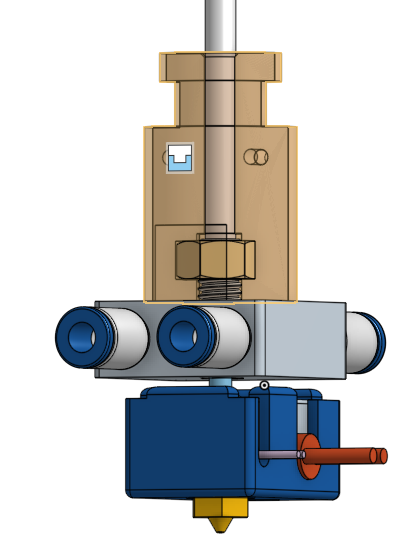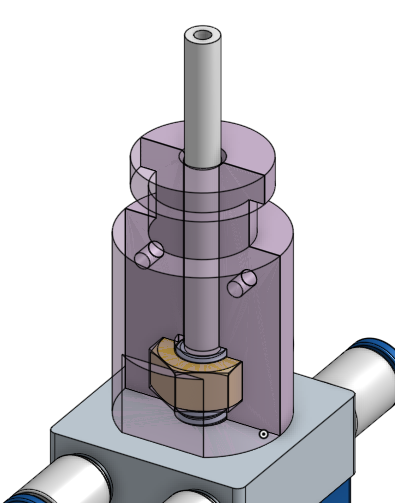Mosquito vs water cooling
-
I've been using Mosquito's for about a year and have also been lucky enough to purchase a Mosquito Magnum Liquid and can offer some experience with heat creep with regard to the OP's question.
First, yes the Mosquito does have less heat creep than a typical v6 heat break. So much less, that the small fan provided with the Mosquito combo is sufficient when not in a heated enclosure. My enclosure is only 65c and I was having severe consistency and clogging issues with the OEM fan. I've tried 40mm fans which are still not enough. I believe the Mosquito design relies heavily on the ambient temperature for cooling and the cooling fins are not large enough when a mosquito is used in an enclosure.
That being said, they have changed the cooling fins (available on their site now) on the heat break. Not sure how the updated design works as I have the original version.
My current project is to test the Mosquito Magnum Liquid. I think this will be perfect for use in my enclosure and should resolve the occasional inconsistencies and clogs. I've never designed a cooling loop so learning about galvanic corrosion, reservoirs, fittings, fluid types, flushing, and all that. Eventually, the cooling loop will be expanded or a second loop added to cool the steppers. Should be a fun project and hopefully help improve consistency.
-
The Mosquito Magnum Liquid sounds like a wonderful addition! As I eventually want to go with a heated enclosure, I will look into this water cooled version.
-
@theruttmeister said in Mosquito vs water cooling:
...............You are already CNC'ing the parts......................
No I'm not. My small milling machine and lathe are completely manual (but fitted with DROs). I have to produce 2D dimensioned drawings on paper for everything I make.
-
Ah.
O-ring recesses in a hole is going to be a bit difficult then... maybe a press-fit plastic seal might be possible though. -
@theruttmeister how about some (silicone) glue instead of o-rings to make it water tight?
-
In an enclosure, a watercooling is the best solution for me. A chimera might very large for a single extruder. I drilled some blocks of aluminium used with the e3d heatbreak.
No more heatcreap with a very small block

All the parts in the watercooling are in aluminium
The first block had a thermistor in it and the mesured temperature remains at 27deg in a 60deg enclosure.
These blocks were made with a drill. -
@tech-raton I am having a bit of a problem visualizing what you have done there. I see the heater and you say you use the E3D heat break so I am assuming that the heat break screws into your cooling block ? I am not sure what the red thing is in the square aluminum tube. How does the filament get guided to the heat break during a filament change ? What is the path of the coolant in that block - is it simply a blind hole at the entrance and exit with a cross drilled path connecting the two blind holes that is then plugged with the bolt shown in the middle of the block side ?
-
Here is what I planned to do for a friend:

The heatbreak is not the standard one, it is a full M6 thread, instead of the standard M6/M7 one.
-
@jens55 said in Mosquito vs water cooling:
@tech-raton I am not sure what the red thing is in the square aluminum tube.
A remote extruder, I think.
@tech-raton, what is the hotend, on the delta? I like round the heat block... Is it a piezo, above the water cooling block?
-
@fma said in Mosquito vs water cooling:
Herre is what I planned to do for a friend:

The heatbreak is not the standard one, it is a full M6 thread, instead of the standard M6/M7 one.
OK so the water cooling block is a straight through drill and then a loop on the far side back into the cooler ? The ptfe tube goes straight to the heat break ? I assume the top thing is the ptfe coupling ?
Is the nut captive somehow in the assembly ? How ?
Sorry about all the questions ....
-
Yup the red thing is a remote extruder.
The watercooling on the corexy is just a 8mm aluminium part with 7 holes drilled
A m7 for the heatbreak
2 m5 for the pushfits
A m4 to connect the 2 m5 holes
3 m3 holes to attach on the carriageOn the delta, the hotend is a maxiwatt with a homemade silicon sock
And yes with a piezo as z probeWhy you heat
-
Thanks for the clarification!
-
Why have 4 pushfits?
You could make a u shape inside your watercooling.
It will reduce the flow but will increase the heat exchange. -
@jens55 said in Mosquito vs water cooling:
OK so the water cooling block is a straight through drill and then a loop on the far side back into the cooler ?
Exactly.
The ptfe tube goes straight to the heat break ?
Yes.
I assume the top thing is the ptfe coupling ?
No, this is the standard groove for hotends. It is designed for direct extruding. But you can modify this part (3D-printed) for Bowden, using a coupler thread.
Is the nut captive somehow in the assembly ? How ?
The 3D-printed part is made in 2 parts (split along the vertical axis), and glued together (there are 2 holes to help aligning it. Here is a closer view:

Sorry about all the questions ....
You welcome! This design hasn't beed tested, and I would love to have feedback if you go that way.
-
@tech-raton said in Mosquito vs water cooling:
Why have 4 pushfits?
Easier to do.
You could make a u shape inside your watercooling.
How? I only have a drill...
It will reduce the flow but will increase the heat exchange.
It is the same, as I use a small external tube to make the half turn.
-
@tech-raton said in Mosquito vs water cooling:
On the delta, the hotend is a maxiwatt with a homemade silicon sock
Thanks! I'll have a look at this block...
-
Ahh, clever! If the ptfe tube is captured by clamping pressure that seems to make clearing a clog kinda tough ???
-
@jens55 said in Mosquito vs water cooling:
Ahh, clever! If the ptfe tube is captured by clamping pressure that seems to make clearing a clog kinda tough ???
As said, I didn't test it, and it may not work as expected. A longer heat break should be better, but I'm not sure if we can find one... But yes, the PTFE tube has to be clampled down, with the above part (extruder or bowden push fit).
-
Well I think that it shows great promise!
-
The goal of this design was to be able to use it in a standard setup (groove), but if you can customize the extruder side, it might be improved...
Another thing to check is if the 3D-printed part can handle the temperature. It should if the water flow is good, but better use PET-G or ABS.